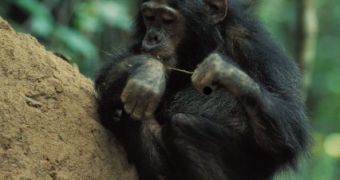You think that only Westerners can steal Daoist sexual practices, martial arts, silk, gunpowder and paper, don't you?
Chimpanzees too have been found to easily take customs and culture from one population to another, just like the humans. This could explain the capabilities of the last common ancestor of humans and chimps, 4 million years ago but also lead to the development of better robots and artificial intelligence.
In the wild, chimpanzee groups often differentiate from one another due to their unique luggage of up to 20 specific customary types of behavior forming particular cultures.
This refers to various forms of tool use: termite fishing with straws in Tanzania, hammers and pestles to crack nuts in Ivory Coast or spears in Senegal, courtship rituals like leaf-clipping, where leaves are clipped noisily with the teeth, social behaviors like overhead hand-clasping during mutual grooming and methods for eliminating parasites by either stabbing or squashing them.
"Until now, there was no evidence that [nonhuman] primates could spread learned behavior from one group to another," said evolutionary psychologist Antoine Spiteri, a doctoral candidate at the University of St. Andrews in Scotland.
He checked if the apes can learn their customary practices by watching others just like humans do, opposed to innate behaviors.
Spiteri's team studied six groups of captive chimpanzees, each with 7-17 individuals, in Bastrop, Texas.
The team taught a lone chimpanzee from each group one different technique for getting fruit from the same complex gadget, like stabbing food with a tool, extracting the food by pushing the gadget out down a ramp, lifting a bar or depositing a coin to access the coveted food or turn a handle to force the fruit down a shoot and then to slide a gadget to guide it into a hole in the box big enough for them to reach in and remove it.
"The more individuals that learn[ed] the task, the more of a tradition it would become," said Spiteri.
In time, each technique for tool use and food extraction spread within the whole group and then in each of them and this was incorporated as part of each group's own culture.
A number of these chimpanzee groups were next-door neighbors within eyeshot of one another, and the team discovered that traditions of the learned foraging practices spread from one group to another. The curious neighbors watched the skilled chimpanzees, getting the point for getting to the food; the new techniques were also passed along to a third group confronted with the strange fruit apparatus. In all, the animals adopted and spread 10 new customs during the trials.
"These results indicate to us that chimps have a capacity for cultural complexity, which was likely shared by our common ancestor going back around 4 million years ago." said Spiteri.
"Female chimps in the wild move from group to group and take learned behavior with them," said Bennett Galef, an animal behaviorist at McMaster University in Hamilton, Ontario,
"Ideally, what I would like to do is look at actual translocations of one chimpanzee from one group to another," said Spiteri.
"This work is particularly useful to robotic development and artificial intelligence. Understanding how the mechanisms of imitation and social learning can help us develop artificial beings that can behave and evolve in the way that we do and ultimately it may help us create other brains." said Spiteri.

 14 DAY TRIAL //
14 DAY TRIAL //